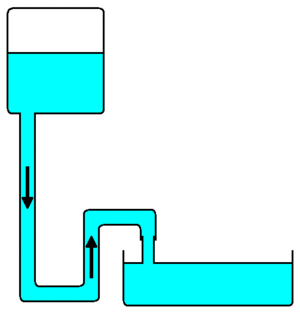Head (hydraulic) facts for kids
Hydraulic head is a specific measurement of water pressure or total energy per unit weight above a datum.
It is usually measured as a water surface elevation, expressed in units of length, but represents the energy at the entrance (or bottom) of a piezometer. In an aquifer, it can be calculated from the depth to water in a piezometric well (a specialized water well), and given information of the piezometer's elevation and screen depth.
Atmospheric pressure
Even though it is conventional to use gauge pressure in the calculation of hydraulic head, it is more correct to use total pressure (gauge pressure + atmospheric pressure), since this is truly what drives groundwater flow. Often detailed observations of barometric pressure are not available at each well through time, so this is often disregarded (contributing to large errors at locations where hydraulic gradients are low or the angle between wells is acute.)
Analogs to other fields
Hydraulic head is a measure of energy, and has many analogs in physics and chemistry, where the same mathematical principles and rules apply:
- Hydraulic head is analogous to:
- A continuous "field" of hydraulic heads is analogous to:
- Similar differential operators can be applied to the fields, to find:
- the gradient, or the direction of flow
- the divergence of flow
- the curl, or if the field is rotating
Other pages
Images for kids
-
Available difference in hydraulic head across a hydroelectric dam, before head losses due to turbines, wall friction and turbulence
-
Measuring hydraulic head in an artesian aquifer, where the water level is above the ground surface
See also
 In Spanish: Cabezal hidráulico para niños
In Spanish: Cabezal hidráulico para niños




